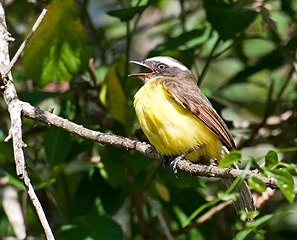Social flycatcher
| Social flycatcher | |
|---|---|

| |
| M. s. colombianus in Antioquia, Colombia | |
| Scientific classification | |
| Domain: | Eukaryota |
| Kingdom: | Animalia |
| Phylum: | Chordata |
| Class: | Aves |
| Order: | Passeriformes |
| Family: | Tyrannidae |
| Genus: | Myiozetetes |
| Species: | M. similis
|
| Binomial name | |
| Myiozetetes similis | |

| |
| Synonyms | |
|
Muscicapa similis (protonym) Myiozetetes texensis (see text) | |
The social flycatcher (Myiozetetes similis) is a passerine bird from the Americas, a member of the large tyrant flycatcher family (Tyrannidae).
It is sometimes split into two species with the social flycatcher, Myiozetetes texensis, from Costa Rica northwards to Mexico and the vermilion-crowned flycatcher, M. similis proper, from southwest Costa Rica across South America.
Description
[edit]In appearance, the social flycatcher resembles a smaller boat-billed flycatcher or great kiskadee. The adult is 16–18 cm (6.3–7.1 in) long and weighs 24–27 g (0.85–0.95 oz). The head is dark grey with a strong white eyestripe and a usually concealed orange to vermilion crown stripe. The upperparts are olive-brown, and the wings and tail are brown with only faint rufous fringes. The underparts are yellow and the throat is white. Young birds have a paler eye mask, reduced crown stripe, and have chestnut fringes to the wing and tail feathers. The call is a sharp peeurrr and the dawn song is a chips-k’-cheery.
As the specific epithet similis (Latin for "the similar one") indicates, this species looks much like its closest living relative the rusty-margined flycatcher (Myiozetetes cayanensis), and also like the white-bearded flycatcher (Phelpsia inornatus), white-ringed flycatcher (Conopias albovittatus) and lesser kiskadee (Pitangus/Philohydor lictor). In fact, except at close range, these are all but indistinguishable from appearance alone. They and the two larger similar species mentioned above share much of their range. Though they all are apparently fairly close relatives, the group to which they seem to belong also includes species with rather different head-pattern, like the grey-capped flycatcher which also belongs to Myiozetetes.
-
M. s. texensis
Belize -
M. s. columbianus
Corcovado, Costa Rica -
M. s. pallidiventris
Brazil
Range and ecology
[edit]
Social flycatchers breed in plantations, pasture with some trees, and open woodland from northwestern Mexico south to northeastern Peru, southern Brazil and northwestern Argentina. It is a common and wide-ranging species and thus not considered threatened by the IUCN.[1]
They like to perch openly in trees, several meters above ground. From such perches they will sally out for considerable distances to catch insects in flight, to which purpose they utilize a range of aerobatic maneuvers. They also regularly hover and glean for prey and small berries—e.g. from gumbo-limbo (Bursera simaruba), which they seek out and also utilize in human-modified habitat such as secondary forest or urban parks and gardens—and will pick off prey from the ground and even enter shallow waters to feed on aquatic invertebrates, tadpoles and occasionally small fish. They have been observed to forage peacefully alongside common marmosets (Callithrix jacchus) in the undergrowth, maybe even cooperating with the monkeys in flushing prey from hiding. Perhaps this behavior only occurs during the dry season, when fruits are scarcer; it has been noted that they do not join mixed-species feeding flocks very often.[3][4][5][6]
The nest, built by the female in a bush, tree or on a building, is a large roofed structure of stems and straw, which for protection is often built near a wasp, bee or ant nest, or the nest of another tyrant flycatcher. The nest site is often near or over water. The typical clutch is two to four brown- or lilac-blotched cream or white eggs, laid between February and June.
References
[edit]- ^ a b BirdLife International (2016). "Myiozetetes similis". IUCN Red List of Threatened Species. 2016: e.T22700586A93785977. doi:10.2305/IUCN.UK.2016-3.RLTS.T22700586A93785977.en. Retrieved 12 November 2021.
- ^ Spix, 1825. Muscicapa similis (protonym). Avium Spec. Nov. Brasil, 2, p. 18, part (not pl. 25). BHL
- ^ Machado, C.G. (1999). "A composição dos bandos mistos de aves na Mata Atlântica da Serra de Paranapiacaba, no sudeste brasileiro" [Mixed flocks of birds in Atlantic Rain Forest in Serra de Paranapiacaba, southeastern Brazil] (PDF). Revista Brasileira de Biologia (in Portuguese). 59 (1). Instituto Internacional de Ecologia: 75–85. doi:10.1590/S0034-71081999000100010.
- ^ de A. Gabriel, Vagner; Pizo, Marco A. (2005). "Foraging behavior of tyrant flycatchers (Aves, Tyrannidae) in Brazil" (PDF). Revista Brasileira de Zoologia. 22 (4). Sociedade Brasileira de Zoologia: 1072–1077. doi:10.1590/S0101-81752005000400036.
- ^ de Lyra-Neves, Rachel M.; Oliveira, Maria A.B.; Telino-Júnior, Wallace R.; dos Santos, Ednilza M. (2007). "Comportamentos interespecíficos entre Callithrix jacchus (Linnaeus) (Primates, Callitrichidae) e algumas aves de Mata Atlântica, Pernambuco, Brasil" [Interspecific behaviour between Callithrix jacchus (Linnaeus) (Callitrichidae, Primates) and some birds of the Atlantic forest, Pernanbuco State, Brazil] (PDF). Revista Brasileira de Zoologia (in Portuguese). 24 (3). Sociedade Brasileira de Zoologia: 709–716. doi:10.1590/S0101-81752007000300022.
- ^ Foster, Mercedes S. (2007). "The potential of fruiting trees to enhance converted habitats for migrating birds in southern Mexico". Bird Conservation International. 17 (1). BirdLife International: 45–61. doi:10.1017/S0959270906000554.
Further reading
[edit]- Skutch, Alexander F. (1960). "Vermilion-crowned flycatcher" (PDF). Life Histories of Central American Birds II. Pacific Coast Avifauna, Number 34. Berkeley, California: Cooper Ornithological Society. pp. 427–446.
External links
[edit]- "Social flycatcher media". Internet Bird Collection.
- Social flycatcher photo gallery at VIREO (Drexel University)
- Social flycatcher species account at Neotropical Birds (Cornell Lab of Ornithology)
- Interactive range map of Myiozetetes similis at IUCN Red List maps







